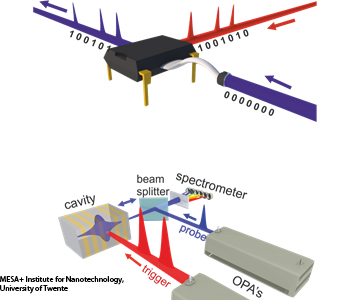
Illustration of the ultrafast all-optical modulator. (Top) The probe beam at right (in blue) carries no information when entering the modulator. The switching beam (in red) encodes its information onto the probe beam. (Bottom) Schematic of the experimental setup. The probe beam, operating at a telecommunications frequency, is shown in blue and the trigger beam in red. Clock rate: 1.4 THz
A new optical microcavity switch that can operate 350 times faster than its electronic counterpart could speed up future telecommunications systems and even quantum computers (Opt. Lett. 38, 374).
Scientists at the University of Twente (Netherlands) and the Institute for Nanoscience and Cryogenics (France) made their semiconductor planar microcavity switch on and off at a reproducible rate of 1.4 THz. By contrast, today's typical electronic switch operates at 4 GHz.
Emre Yüce, a junior scientist at Twente's MESA+ Institute for Nanotechnology, and his collaborators fabricated the cavity out of layers of gallium arsenide and aluminum arsenide and measured its resonance frequency at 1,284.1 nm. In the experiment, the team used two optical parametric amplifiers, pumped by a near-infrared Ti:sapphire laser, to shoot probe and trigger light beams into the tiny cavity.
The trigger beam creates the so-called electronic Kerr effect, which changes the refractive index of the cavity material on a subpicosecond time scale. The researchers lengthened the wavelength of the trigger beam to 2,400 nm to reduce two-photon absorption within the cavity; they estimated that the cavity absorbed only about one millionth of the light input.
The cavity storage time of roughly 300 fs determines the fundamental “speed limit” of the switching rate, according to the authors. The phenomenon is not dependent on the geometry of the microcavity.
Besides ultrafast on-chip photonic modulation, the new switch could find applications in fundamental studies of cavity quantum electrodynamics.
